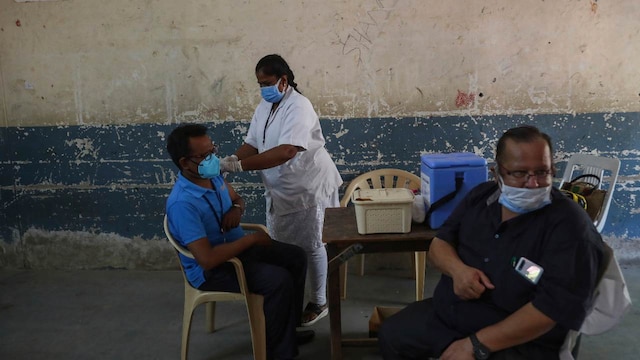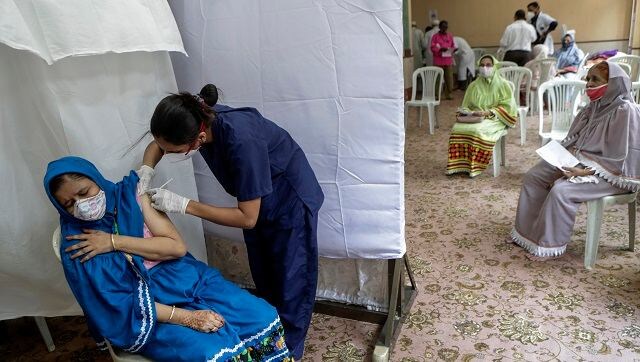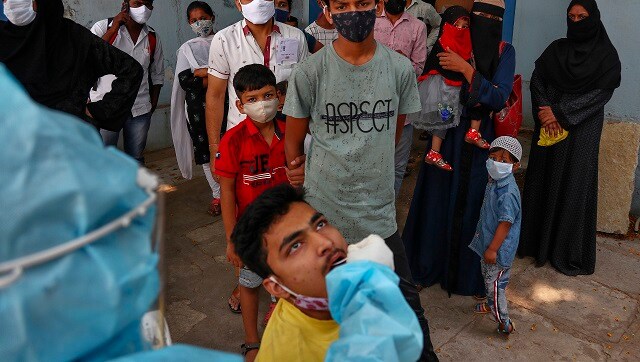COVID-19 updates: Bihar, Lakshadweep, Assam ease curbs; Amarnath Yatra cancelled for second year straight
The Assam government eased lockdown-like restrictions in eight districts but warned that in may impose stricter curbs in some other districts if the situation does not improve

File image of a heath worker in protective suit taking a nasal swab sample of a man to test for COVID-19 in a residential area in Gauhati, Assam. AP
The Bihar government on Monday announced easing of COVID-19 induced restrictions in the state while Karnataka added six more districts to its category-1 where curbs have been relaxed. The Assam government eased lockdown-like restrictions in eight districts but warned that in may impose stricter curbs in some other districts if the situation does not improve.
induced restrictions in the state while Karnataka added six more districts to its category-1 where curbs have been relaxed. The Assam government eased lockdown-like restrictions in eight districts but warned that in may impose stricter curbs in some other districts if the situation does not improve.
Also on Monday, on the first day of implementing the revised vaccination guidelines, a record 82.7 lakh doses were administered, with Prime Minister Narendra Modi remarking that the numbers are "gladdening" and reiterating that the vaccine remains "our strongest weapon to fight COVID-19 ".
".
Today’s record-breaking vaccination numbers are gladdening. The vaccine remains our strongest weapon to fight COVID-19
. Congratulations to those who got vaccinated and kudos to all the front-line warriors working hard to ensure so many citizens got the vaccine.
Well done India!
— Narendra Modi (@narendramodi) June 21, 2021
These developments took place on a day when India logged 53,256 new coronavirus infections, the lowest in 88 days, taking the total tally of COVID-19
infections, the lowest in 88 days, taking the total tally of COVID-19 cases to 2,99,35,221. The COVID-19
cases to 2,99,35,221. The COVID-19 toll mounted to 3,88,135 with 1,422 fresh fatalities, the lowest in 65 days, according to the Union health ministry's morning update.
toll mounted to 3,88,135 with 1,422 fresh fatalities, the lowest in 65 days, according to the Union health ministry's morning update.
Active cases declined by 26,356 and reached 7,02,887 comprise 2.35 percent of the total infections, while the national COVID-19 recovery rate improved to 96.36 percent. Recoveries continue to outnumber daily new cases for the 39th consecutive day.
recovery rate improved to 96.36 percent. Recoveries continue to outnumber daily new cases for the 39th consecutive day.
The ministry said the weekly positivity rate has declined to 3.32 percent. The daily positivity rate was recorded at 3.83 percent.
The COVID-19 positivity rate has been less than 5 percent for 14 consecutive days, conforming to the WHO's recommended requirement for a region to reopen but experts were wary of declaring the devastating second wave over.
positivity rate has been less than 5 percent for 14 consecutive days, conforming to the WHO's recommended requirement for a region to reopen but experts were wary of declaring the devastating second wave over.
Citing the emergence of new variants, the still high absolute number of cases, the many districts where positivity rate remains over 5 percent and concerns over reliability of data, scientists told news agency PTI that the optimistic picture must be edged with abundant caution.
All offices in Bihar to operate with full strength
Bihar chief minister Nitish Kumar on Monday announced that from 23 June to 6 July, all government and non-government offices will operate with full staffing, shops will remain open till 7 pm and night curfew will be imposed from 9 pm to 5 am. Parks and gardens will be open between 6 am and noon, the chief minister said on Twitter while emphasising that the need to remain cautious continues.
कोरोना संक्रमण की स्थिति की समीक्षा की। 23 जून से 6 जुलाई तक सरकारी एवं गैर-सरकारी कार्यालय शत-प्रतिशत उपस्थिति के साथ काम करेंगे, दुकानें 7 बजे संध्या तक खुलेगी, रात्रि कर्फ्यू रात्रि 9 बजे से सुबह 5 बजे तक लागू रहेगा। (1/2)
— Nitish Kumar (@NitishKumar) June 21, 2021
Karnataka eases curbs in six more districts
The Karnataka government added six more districts to the list of 17 districts under "Unlock 2.0", where hotels, gyms, and public transport bus services have been allowed to resume operations.
Udupi, Bengaluru Rural, Shivamogga, Ballari, Chitradurga and Vijayapura have been placed under Category-1 after considering the weekly moving average positivity rate and also taking into account the consistent declining trend of the COVID-19 case positivity rate, the state government said in its order.
case positivity rate, the state government said in its order.
In all, the state government has now relaxed COVID-19 restrictions in 23 districts.
restrictions in 23 districts.
However, as the state entered into another phase of relaxation of lockdown measures on Monday, Chief Minister BS Yediyurappa told people not to be under the 'illusion' that the COVID-19 pandemic is gone and asked them to be vigilant and follow all the precautionary preventive measures.
pandemic is gone and asked them to be vigilant and follow all the precautionary preventive measures.
Lakshadweep allows fishing, construction activities
The Lakshadweep administration too announced some relaxations to the COVID-19 induced lockdown as cases have come down in all the 10 inhabited islands.
induced lockdown as cases have come down in all the 10 inhabited islands.
The administration, which is facing protests from the Opposition parties over its reform measures, has decided to allow political, social and religious functions but only with the prior permission of the District Collector of the Lakshadweep.
It has also decided to allow fishing, construction and developmental activities besides permitting hotels and restaurants to open from 7 am to 9.30 am, 1 pm to 3 pm and 6 pm to 9 pm only for home delivery of packed food items subject to follow standard operating procedure and COVID-appropriate behaviour at all times.
Shops and establishments shall be allowed to open (only five persons inside a shop at a time) in all the islands, it said.
Although the COVID-19 situation has been stabilised and there are only 319 cases in the islands, there is still a necessity to regulate the movement of people, ensure strict enforcement of prescribed containment strategies and focus on surveillance to prevent the further spread of the virus in the islands, the administration said.
situation has been stabilised and there are only 319 cases in the islands, there is still a necessity to regulate the movement of people, ensure strict enforcement of prescribed containment strategies and focus on surveillance to prevent the further spread of the virus in the islands, the administration said.
Complete shutdown (corona curfew) will be imposed during the weekend and night curfew will kick in between 5 pm to 6 pm.
Assam eases curbs in eight districts
In Assam, restrictions were eased in eight districts — South Salmara, Majuli, Bongaigaon, Chirang, Udalguri, West Karbi Anglong, Dima Hasao, and Charaideo — where cumulative COVID-19 cases have been less than 400 in the last ten days. The movement of people has been allowed in the eight districts from 5 am to 5 pm, said an order.
cases have been less than 400 in the last ten days. The movement of people has been allowed in the eight districts from 5 am to 5 pm, said an order.
Though the daily count has declined in Kamrup Metropolitan, which still has the highest number of coronavirus cases in the state, there will be a total ban on movement of individuals from 2 pm to 5 pm daily, which has been relaxed by an hour from the earlier 1 pm.
cases in the state, there will be a total ban on movement of individuals from 2 pm to 5 pm daily, which has been relaxed by an hour from the earlier 1 pm.
In the remaining districts, a ban on the movement of individuals from 1 pm to 5 pm, imposed since 4 June, will continue to be in force until further orders. All inter-district transport services and movement of people to and from other districts shall remain suspended until further orders.
Government or semi-government officers in the rank of Deputy Secretary and above and senior executives in the non- government sector along with their key support staff will have to attend office for emergency and urgent work, irrespective of their vaccination status.
Pregnant employees and women with children below the age of five working in any government, PSU, financial institution, private organisation, irrespective of their grade, shall be eligible to work from home while persons with disabilities working in any of these organisations shall be exempted from duties though they may be encouraged to work from home.
The Assam government is closely monitoring districts with high COVID-19 prevalence — Cachar, Tinsukia, Dibrugarh, and Sonitpur — and may enforce stricter curbs if there is no improvement, the order issued by Jishnu Baruah, Chief Secretary in his capacity as the Chairperson of the State Disaster Management Authority said.
prevalence — Cachar, Tinsukia, Dibrugarh, and Sonitpur — and may enforce stricter curbs if there is no improvement, the order issued by Jishnu Baruah, Chief Secretary in his capacity as the Chairperson of the State Disaster Management Authority said.
In case the positivity rate in any area reached five percent or more in urban areas, and ten percent or more in rural areas, in the past one week, the district magistrates will notify such areas as containment zones and ensure necessary measures in those areas.
Other restrictions, imposed earlier, will remain in force across the state, the order said.
'Amarnath Yatra to be symbolic'
Meanwhile, Jammu and Kashmir lieutenant-governor Manoj Sinha said that in the wake of the pandemic, the UT administration has decided that the annual Amarnath Yatra will be kept symbolic.
The 56-day yatra to the 3,880-metre-high Himalayan cave shrine was proposed to start from the twin routes of Pahalgam and Baltal on 28 June and culminate on 22 August. This is the second consecutive year that the pilgrimage has been called off due to the pandemic.
He said that at the shrine, all traditional and religious rituals shall be performed according to past practice.
"It's important to save people's lives. So, it is not advisable to hold and conduct this year's pilgrimage in the larger public interest. Shri Amarnathji Shrine Board (SASB) is aware of and respects the sentiments of millions of devotees, and to keep the sentiments alive, the board shall continue the live telecast of morning and evening 'aarti' from the holy cave shrine," Sinha, who is also the board's chairman, said.
He directed officials to ensure devotees can virtually attend the morning and evening 'aartis' (prayers) at the shrine. This will allow them to pay their obeisance while also avoiding travel and exposure to the infection, the L-G said.
Is second wave over?
With the current positivity rate at less than five percent, India's COVID-19 second wave is on the wane as quickly as it rushed to its peak, but the end of it may yet be far away as more transmissible new variants such as Delta plus variant are emerging, said Naga Suresh Veerapu, associate professor at the School of Natural Sciences (SoNS), Shiv Nadar University, Delhi NCR.
second wave is on the wane as quickly as it rushed to its peak, but the end of it may yet be far away as more transmissible new variants such as Delta plus variant are emerging, said Naga Suresh Veerapu, associate professor at the School of Natural Sciences (SoNS), Shiv Nadar University, Delhi NCR.
In February, the country was celebrating the end of the first wave and conveniently ignored an imminent second wave, Veerapu said. The Delta variant that emerged in March spread across the different parts of India, then cases surged to the peak yielding a second wave. The second wave conjoined with the first when the latter was at one percent positivity rate, he told PTI.
Public policy expert Chandrakant Lahariya added that while the cases are on the decline, the absolute number of cases are still very high.
While the national level test positivity rate has come down, there are still many districts where TPR is above 5 percent, the Delhi-based physician-epidemiologist and health systems expert told the news agency.
Therefore, before saying that the second wave is over, I would like to wait for the TPR to come down below 5 percent everywhere and sustain for two weeks or longer, Lahariya said.
There is no strict definition of a wave', let alone of how and when it might be ending, but this is a good time as any to consider opening up, although with caution, Gautam Menon, professor, Departments of Physics and Biology, Ashoka University in Haryana, told PTI.
The experts also believe test positivity rates provide valuable information only if testing is broadly accessible across all regions.
Test positivity, when these tests are carried out on a random sample of the population and in sufficient quantity, is likely the best metric to dictate opening up, although we must be careful about local pockets where the level of infections have been lower than average and where the disease could still take off, said Menon.
What we need to remember is that for a country the size of India, we need to have enough attention on the local level, Lahariya added.
He explained that COVID-19 is not just any other respiratory illness and decision-making parameters cannot be simple.
is not just any other respiratory illness and decision-making parameters cannot be simple.
"We know that there are new variants which are more transmissible. We know that human behaviour determines the spread of this virus. Therefore, it is not very relevant if we declare whether the second wave is over or not, the public policy expert explained.
"Key is, are we prepared to respond to the rise in cases? That's where the attention has to be," Lahariya said.
Widespread concerns about the accuracy of data, relating to both deaths and cases, also need to be factored in, said Menon.
Lahariya said India has sub-optimally performing mechanisms for medical certification of causes of deaths (MCCD). Even before the pandemic, the causes of deaths used to be certified in only one-fourth of registered deaths. Therefore, it is not unthinkable that even in some cases of COVID-19 deaths; deaths have not been certified correctly, the scientist added.
deaths; deaths have not been certified correctly, the scientist added.
Veerapu said the underestimation of cases might occur as asymptomatic people and some with mild symptoms may not even turn up for testing.
However, he added that the waning second wave provides enough opportunities to minimise the spread of the disease. We should ramp up the vaccination drive, consolidate the health infrastructure to minimise the impact of the much anticipated third wave, and hone the public health strategies to prevent, control and respond to the third wave, he said.
With inputs from PTI
also read

Covishield produced more antibodies than Covaxin, finds preliminary study
The study, which is a preprint and has not been peer-reviewed, should not be used to guide clinical practice. However, it claimed that seropositivity rates to anti-spike antibodies were significantly higher in Covishield recipients

COVID-19 Updates: Free vaccines for adults from 21 June, says Modi; Covaxin trials on children begin
Under the previous policy, the Central government procured 50 percent of vaccines for distribution for free vaccination of those above 45 years and frontline workers

COVID Updates: Daily cases decline by 78% decline since May peak; ICMR to start national sero survey
Citing the sustained decline in daily coronavirus cases, the Centre said the COVID-19 situation in the country 'appears to be stabilising'